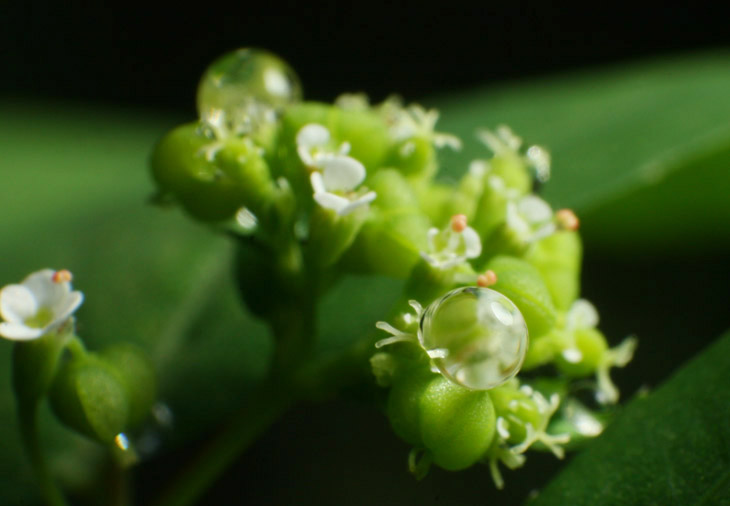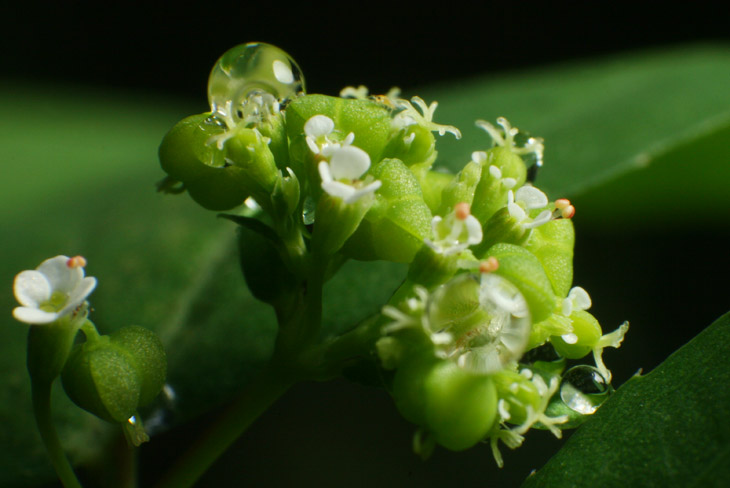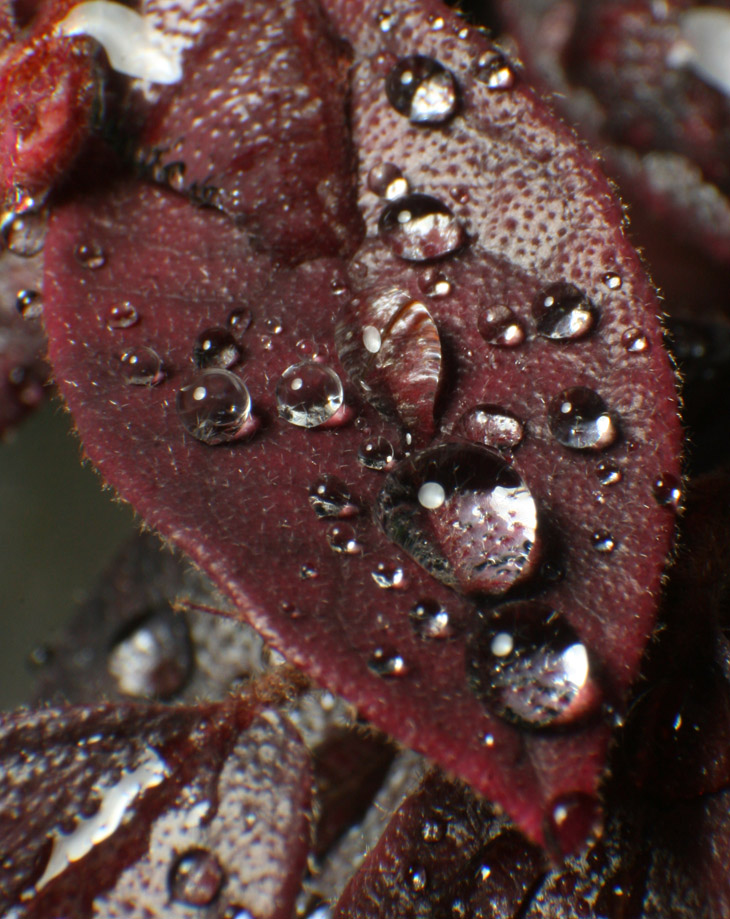You undoubtedly remember the butterfly bushes that have served as a setting for some of the more recent pics here, but they have company – unintended neighbors, as it were. We maintain a compost bin, and use this as soil booster for all of the repotting and transplanting that we do, and naturally the result is that we almost always have something else that sprouts from the pot afterwards. In this case it’s something that appears to be a small tree, but what exactly it is I cannot say, due to advice from my lawyer (he said, “Al, if you don’t know what the fuck a plant is, stop guessing – these suits are gonna kill us.”) Distinctive about this plant, or alleged plant, are the tiny flowers it produces, a couple of millimeters wide at best – the kind of flowers that would make a tree own an oversized jacked pickup truck and talk loudly and aggressively in bars. And after a recent rain, they were sporting proportional drops of water – yes, little balls, too. I really haven’t been shooting a lot recently, except for something else that will be appearing here soon, so I did a quick photo session.
Actually, it was intended to be quick, but took a bit longer than anticipated, then a lot longer as I decided to illustrate something all-too-common with macro work. First, the pics.

These flowers and droplets are so small (hinted at by the perfectly spherical shapes of the water) that I was using the reversed Sigma 28-105, so very high magnification and commensurately short depth of field – even at f16, there’s really no depth. This is a cropped image, by the way, so a bit tighter than I was shooting and thus seeing in the viewfinder. The closest drop looks great, but not much else is sharp. Compare that against another frame.

Now the flowers look much better and there are more droplets in focus, especially that one at lower right – but the original drop has produced a disconcerting effect from going past the point where its edges are focused but finding the point where it acts as a lens for the vegetation behind it. These frames are good candidates for image stacking, the technique where you take the sharpest parts of multiple frames and combine them into one image. Yet what it really illustrates is just how precise focus distance must be to capture what you’re after – the higher the magnification, the more precise you must be. Trying to hold still in an exact position, with no greater than three millimeters variation, is more than challenging, and usually I’m just timing the shutter trip with the tiny bit of swaying that I’m doing. Yes, one could use a tripod – in certain circumstances, and this wasn’t one of them. But then, there’s the added element, which occurs very often: the breeze.
There’s nothing like macro work to make you realize how rarely the air is really holding still, and this is driven home when you choose a subject on the top of thin and flexible stalks. Thinking about a post as I was doing the shots, I recognized that video was going to illustrate this a lot better, and so here we are:
Right away I’m going to admit that I’m still learning video and editing work, so don’t pick on me. I’m struck, repeatedly, with the fact that while a DSLR allows a full complement of specialty lenses to be used, it’s still one of the most ridiculous ways to do video, especially with the Canon T2i which does not have an articulated LCD screen, so you’re forced to shoot in the worst possible position for steadiness in order to even see what you’re shooting – the viewfinder cannot be used, so you’re holding the camera out like a temple offering to frame with the LCD screen.
Meanwhile, the timing of the crows cawing was completely unintended – I knew they were in the audio, but recorded the voiceover track separately and had no idea where they would fall. But I’ll take it anyway.
The long and short of it is, you wait for the space between gusts, and do what you can to steady yourself at least (I was using a chair to provide some stability.) And one of the better techniques, when it can be utilized, is shooting at night when the air tends to be much calmer. But this daytime session meant a lot of trashed frames and more drain on the flash batteries. Still, it worked enough.

This is probably my favorite frame, from a slightly different angle but capturing a prominent drop and some of the blossoms in sharp focus together – again, this is pretty damn hard to see adequately in the viewfinder, but at least for still photos I could use the viewfinder. I will admit that the breeze and my abysmal inability to hold amazingly motionless meant a certain element of pure chance was involved in capturing these shots, but I improved the odds by shooting quite a few images in between gusts.
And one more, to illustrate something else.

This is not the same plant of course, but the leaves of The Girlfriend’s Chinese fringe flower (Loropetalum chinense) showing off their water-repellent properties. I went with a tight crop of a larger frame to show something distinctly. If you look close, you can see that several drops are sporting reflections from the flash softbox, nice round and diffuse circles instead of, for instance, rectangular shapes or bright sunbursts from an undiffused flash tube. The effect becomes very subtle and quite natural-looking, and I encourage its use for anyone’s macro lighting rigs. Now that I’ve pointed it out here, you can go back and notice that it’s visible in all of the frames above too – but did you see it at the time?



















































